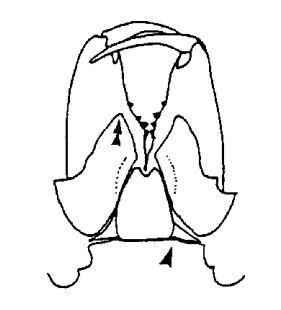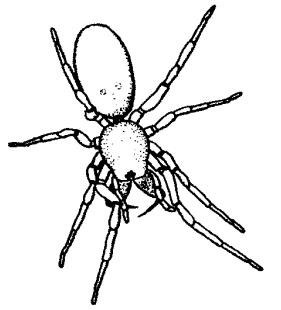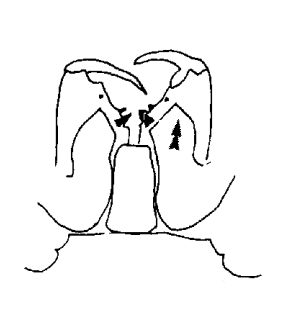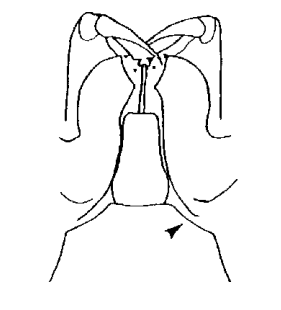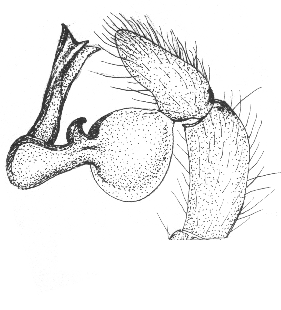Family Dysderidae C. L. Koch, 1837
Key not complete! Further genera listed at the end of key |
In case you find an error or have a specific suggestion, please follow this link: click
|
||||
| 1 |
All tarsi with claw tufts, posterior metatarsi with scopulae. Anterior border of sternum with labial junction much wider than maxillar junction (Dysderinae) |
||||
| - | Anterior tarsi without claw tufts and with 3 claws |
||||
| 2 (1) |
Male bulbus cylindrical |
||||
| - | Male bulbus globular |
||||
| 3 (2) |
3-4 cheliceral teeth in one row, anterior edge of labium with a distinct notch, PME with less than 0.5 diameter distant from PLE, male bulbus composed of 2 sclerotized parts with a large apophysis, vulva with an anterior arc-shaped diverticle |
| |||
| - | Different |
||||
| 4 (3) |
Chelicerae with 4 teeth in two rows, labium twice as long as wide, bulbus with large chitinous strip at the end, vulva with anterior arc-shaped diverticle, PME 0.5 – 1.5 diameter distant from PLE |
||||
| - | Chelicerae with 3 teeth in promargin row and 2 teeth in retromargin row, PME with less than 0.5 diameter distant from PLE, bulbus with a short and simple chitinised strip at its end, vulva with anterior diverticulum reverse T-shaped, posterior diverticulum large, with 2 lateral wings |
||||
| 5 (2) |
Bulbus simple with a long, thin and often sinuous distal part, PLE 1 diameter from PME |
| |||
| - | Bulbus with 2 subapical apophyses |
||||
| 6 (1) |
Anterior edge of sternum with labial junction as wide as maxillar junction. Chitinous strip between all coxae, absent between coxa 1 and maxillae (Harpacteinae) |
| |||
| - | Anterior edge of sternum with labial junction much wider as maxillar junction. Chitinous strip between all coxae and between coxa 1 and maxillae (Rhodinae) |
||||
| 7 (6) |
Sternum dull; embolus usually longer than bulbus, angular at its base, bulbus with a conspicuous distal projection; vulva entirely sclerotized, anterior part reverse T-shaped |
| |||
| - | Different |
||||
| 8 (7) |
Bulbus globular with thin, transverse embolus |
||||
| - | Bulbus not globular, embolus different |
||||
| 9 (8) |
Eyes form a circle, posterior eyes close-by; sternum shining; distal bulbus processes not longer than bulbus, 2-3 processes often like forceps Harpactea |
||||
| - | Different |
||||
| 10 (9) |
Bulbus with a very large curved apophysis with teeth and lobes, 1 species from Corsica |
||||
| - | Different |
||||
| 11 (10) |
Eyes reduced or absent, vulva with reverse V- or Y-shaped spermatheca, wide posterior diverticulum not sclerotized |
||||
| - | Median eyes smaller than lateral eyes, legs spineless, vulva with bacilliform spermatheca, posterior diverticulum not sclerotized |
||||
| 12 (8) |
Eyes form a circle, posterior eyes close-by; sternum shining; distal bulbus processes not longer than bulbus, 2-3 processes often like forceps |
||||
| - | Eyes reduced or absent |
||||
| 13 (12) |
Tibia II without spines Harpactea |
||||
| - | Tibia II with spines |
||||
| 14 (12) |
Bulbus simple, 2 cave species from Crete |
||||
| - | Bulbus with broad embolus, 1 species from Spanish caves |
||||
| 15 (6) |
Legs spineless, posterior part of prosoma with a central lobe |
||||
| - | Different |
||||
| 16 (15) |
Mesostalita, Stalita und Parastalita: distal part of the bulbus with a row or a field of teeth or spines (In 3 out of 8 species only one sex is known and limitations of genera is difficult) |
||||
| - | |||||
| - | |||||
| - | Distal part of the bulbus without teeth or spines |
Further genera
- 1. Cryptoparachtes
- 2. Kut
- 3. Rhodera
- 4. Sardostalita
- 5. Stalitochara
